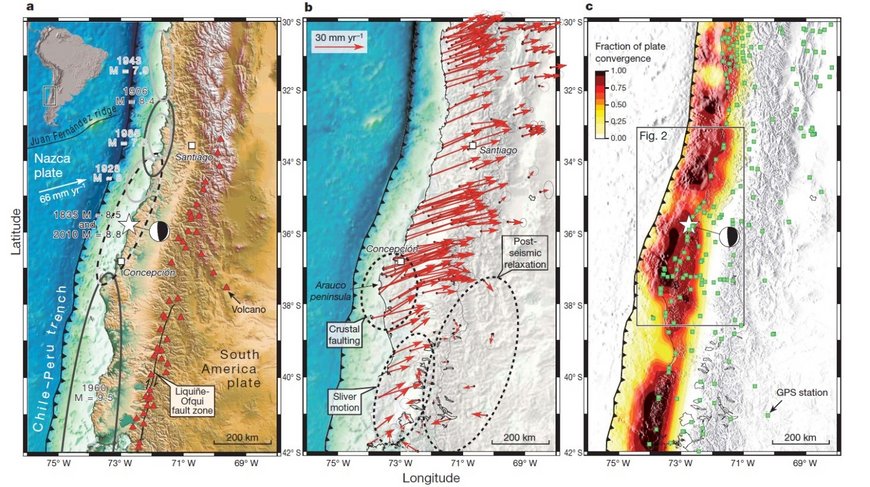Time Frame: 2015-2019
Funding: CONICYT - Comisión Nacional de Investigación Científica y Tecnológica (Chile)
Principal Investigators:Oliver Heidbach, Onno Oncken and Marcos Moreno
Personnel: Ph.D. student Carlos Pena
Cooperations: Jonathan Bedford, GFZ Sektion 4.1, Deutschland; Fabrice Cotton und Steffi Lammers, Sektion 2.6, Deutschland; Sergio Barrientos, Univ. de Chile, Chile;
Earthquakes in subduction zones and tsunamis triggered by these are one of the most natural hazards on Earth. This we have learned in the past decade from the megathrust events in Indonesia in 2004 (Mw 9.2), Japan in 2011 (Mw 9.0) and from the two events in Chile in 2010 and 2014 (Mw 8.8 and Mw 8.2). In particular in Chile the seismic hazard is very high due to the 3,000 km long subduction zone along its coast and the relatively high subduction velocity of the Nazca plate (6-7 cm/year). The high hazard is also expressed in the fact that about one quarter of the global seismic energy release occurred here in the past century. In order to further improve the mitigation strategies a prerequisite is a quantitative understanding of the geodynamic processes that control the strain built-up and strain release within the seismic cycle. In particular it is important to enhance the reliability of the forecast model for the maximum magnitude and the co-seismic slip displacement.
The unique seismological and geodetic data sets that were recorded before, during and after the Maule and Iquique event in 2010 and 2014, respectively, enable us now to address one of the key question in that context: Is the spatio-temporal evolution of fluid pressure in the plate interface the key control of the seismic cycle? In particular the fluid pressure increase in the interseismic phase and its re-distribution in the post-seismic phase seem to play a key role for the co-seismic displacement, i.e. magnitude of the event, and the location of strong aftershocks (Bedford, et al., 2013; Moreno et al., 2014). Another key question is if fluid pressure changes leave an imprint in the geodetic deformation signal and how these changes are related to changes of seismic wave velocities. The project PhD work will focus on these two questions using the extensive and unique data sets acquainted in the past years in Chile. We set up 2D semi-generic models to study the underlying hydro-thermo-mechanical processes that control the fluid pressure evolution at the plate interface.
Tectonic setting of the study area, data, observations and results | (Moreno et al., 2012) a), Shaded relief map of the Andean subduction zone in South-Central Chile. Earthquake segmentation along the margin is indicated by ellipses that enclose the approximate rupture areas of historic earthquakes (updated from refs 4–6). The inset shows the location of panel a (rectangle) relative to the South American continent. b) Compilation of GPS-observed surface velocities (1996–2008) with respect to stable South America before the 2010 Maule earthquake (for references see online-only Methods). Ellipses attached to the arrows represent 95% confidence limits. c) GPS 1 FEM modelled interface locking (fraction of plate convergence) distribution along the Andean subduction zone megathrust in the decade before the 2010 Maule earthquake. The epicentre (white star, USGS NEIC) and focal mechanism (beach ball, GCMT, www.globalcmt.org) of the 2010 Maule earthquake are shown in panels a and c.
Publications/Results
- Hergert, T., and O. Heidbach (2006). New insights in the mechanism of postseismic stress relaxation exemplified by the June 23rd 2001 Mw = 8.4 earthquake in southern Peru. Geophys. Res. Lett., 33, L02307, doi.org/1029/2005GL024585
- Moreno, M., Rosenau, M. and O. Oncken (2010). Maule earthquake slip correlates with pre-seismic locking of Andean subduction zone. Nature 467, 198-204, doi.org/110.1038/nature09349
- Moreno, M., C. Haberland, O. Oncken, A. Rietbrock, S. Angiboust, and O. Heidbach (2014). Locking of the Chile subduction zone controlled by fluid pressure before the 2010 earthquake. Nature Geosciences, doi.org/10.1038/ngeo2102
- Bedford, J., M. Moreno, S. Li, O. Oncken, J. C. Baez, M. Bevis, O. Heidbach, and D. Lange (2016). Separating rapid relocking, afterslip, and viscoelastic relaxation: An application of the postseismic straightening method to the Maule 2010 cGPS data. J. Geophys. Res., 121, doi.org/10.1002/2016JB013093
- Li, S., Moreno, M., Bedford, J., Rosenau, M., Heidbach, O., Melnik, D. and O. Oncken (2017). Postseismic uplift of the Andes following the 2010 Maule earthquake: Implications for mantle rheology. Geophys. Res. Lett. 44, 1768–1776, doi.org/10.1002/2016GL071995




